Erica Synths Perkons Voice
Single voice from the Perkons HD-01 in Eurorack format
Author: Peter Kaminski | Photos: Peter Kaminski and archive (2)
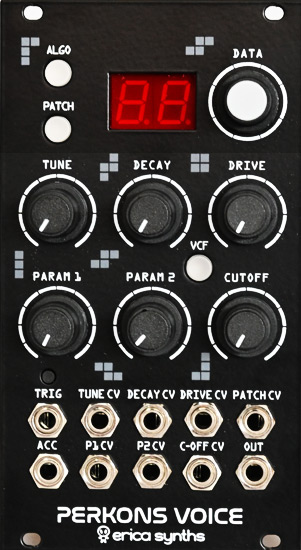
Latvian manufacturer Erica Synths offers a whole range of electronic drum and percussion instruments. These include the Perkons HD-01 drum machine in a desktop format with four voices and an integrated step pattern sequencer. Perkons HD-01 is a versatile drum and percussion instrument. Since July 2025, one voice of the Perkons has also been available as a module in Eurorack format - and we would like to take a closer look at in this review. Incidentally, “Pērkons” is a Latvian word meaning ‘thunder’ or “thunderstorm.” Let's see if the Perkons Eurorack module is as powerful as its name promises.
Technical specifications
The module is designed like a sandwich, stacking two circuit boards on top of each other: one for the controls and jacks and another for the other electronic components, complete with SMD assembly. The module is 14 HP wide with a depth of 35 millimeters.
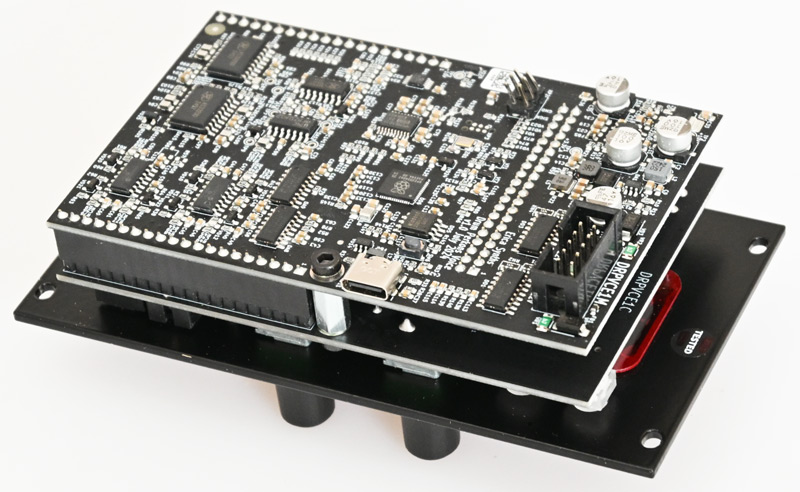
The power consumption is approximately 55mA with a +12 volt power supply and approximately 3mA with -12 volts. On the rear panel, next to the power connector for the module, there is a USB-C socket for connecting to a computer to update the module's firmware. The audio output level is 10 volts peak/peak, and the CV input voltage range is -5 to +5 volts.
Concept
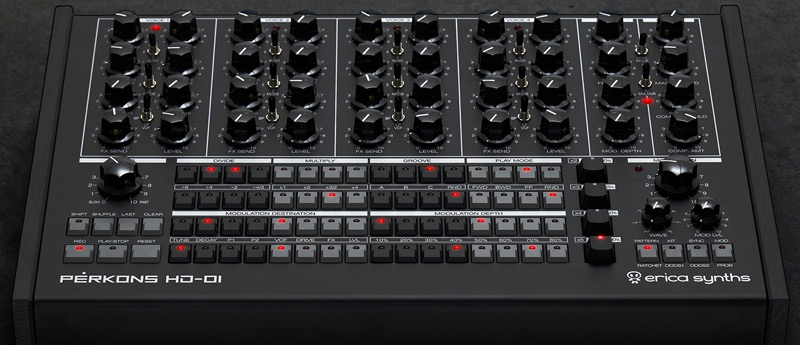
Let's take a closer look at the user interface of the Perkons HD-01. The pattern sequencer is located at the bottom, with four voices and a master section at the top.
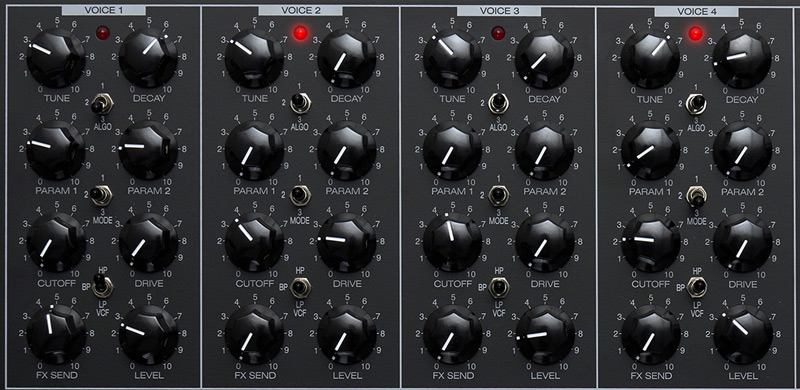
If you look at the four voices of the Perkons HD-01, you will notice that they look very similar. The functions of the knobs are also identical. However, the Perkons HD-01 offers three algorithms with three modes per voice. These are not the same for all voices, but the algorithms and modes are mostly different. Parameters 1 and 2 adjust themselves accordingly depending on the selected algorithm or mode.
The Perkons Voice Eurorack module, on the other hand, offers a selection of 13 algorithms with variations, namely:
- A1 to A3: Fold Drum 1 (sine waveform)
- B1 and B2: Complex Drum (FM synthesis)
- C1 to C3: Wave Morth Drum (wavetable-based)
- D1 to D3: Pulse Drum
- E1: Resonant Bass Drum (based on resonance filter)
- F1: Resonant Snare Drum (based on resonance filter)
- G1: Space Snare
- H1: Slap (analog clap sound)
- I1 to I3: Karplus Strong
- J1 and J2: Cymbals
- K1: Noise Crush
- L1: Metallic Noise
- M1 to M3: Sample Player
This list shows that Perkons Voice is based on the algorithms and modes of Perkons HD-01, but it is not an exact mirrored image. The sample player is available as an extra feature. The different variations are slight modifications, such as different transient shaping or different wavetables, etc., which can be changed on the Perkons HD-01 by selecting the mode.
Operation
Now let's move on to the operation of the Perkons Voice. The two-digit 7-segment display shows the algorithm or the selected patch, depending on what you have selected. Use the encoder to the right of the display to select the algorithm or patch.
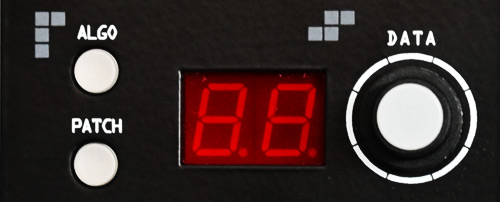
When an algorithm is displayed, you can switch between “Mono” and “Poly” play modes by pressing the rotary encoder. In Mono mode, a new trigger starts a new voice, and the previous one stops. In Poly mode, the triggered voice continues to be played, and the new voice starts. Up to four voices can sound simultaneously in Poly mode. If a patch is displayed, press briefly to load the preset, and press and hold to save it in the selected preset. Up to 99 patches can be saved.
Pressing the buttons ALGO and PATCH in succession takes you to the setting mode, where you can adjust 14 parameters, such as the default voice mode (mono/poly), the voltage range of the control voltage inputs, patch loading mode (encoder press required or immediate switching), and switching from factory to user samples. You can also perform calibration and restore the default settings here.
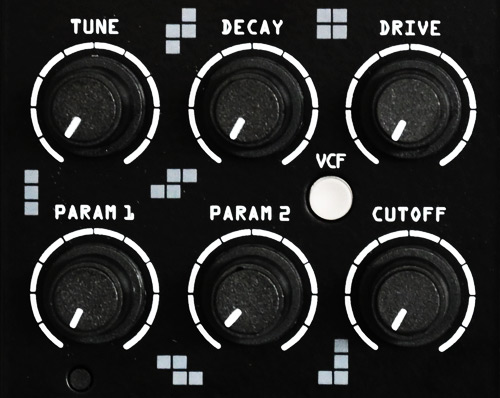
Below are six knobs for pitch, decay time, level or drive, filter frequency, and two parameters that change depending on the selected algorithm. For algorithms A1 to A3, for example, these are the size of the pitch envelope or the degree of modulation. In the first version of the manual, the description of parameters 1 and 2 for algorithm A appears to be reversed.
In many algorithms, parameter 1 can also be used to set the reverb or noise level. Parameter 2 controls, among other things, the filter setting or the degree of attack envelope. The VCF button allows you to switch between low-pass, high-pass, and band-pass filter types. The intensity of the LED usually indicates which filter type is selected.
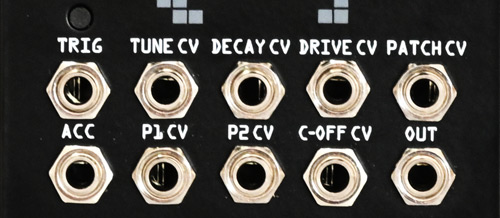
Now let's take a look at the ten inputs and outputs. In addition to the monophonic audio output, there is a trigger and an accent input for emphasis (plus 2dB). Above the trigger input, there is also a small button for manual triggering. Furthermore, all six adjustable parameters can be modified using control voltages.
PATCH CV even allows for selecting patches via a control voltage. The factory default voltage range of 0 to +5 volts is assigned to the first 60 presets, i.e., one patch per semitone step (0.0833 V). This range and the start patch number can be adjusted using the configuration settings mentioned above.
In practice
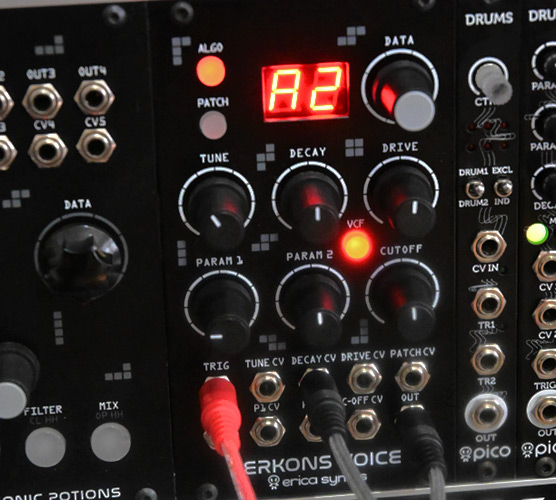
Fortunately, the module is designed for intuitive operation. Unlike so many other modules on the market, it is not overloaded with functions. At first, it may be helpful to have a page with the algorithms and the assigned parameters 1 and 2 when operating. But after a little experience with the module, you just turn one of the knobs, hearing what changes. It's great that all parameters can be changed via control voltages. This also allows you to quickly create dynamically changeable drum sounds.
Three hi-hat samples are stored by default for the “M” algorithm. You can store three alternative samples in the module via USB. They must have the file names “1”, ‘2’ or “3”, a sample rate of 48kHz and a word length of 16bits, and the files may not exceed 256kB in size. One small restriction is that files that reach this maximum limit must be uploaded individually. Otherwise, an error may occur. However, this is also highlighted in the manual. Switching between factory and user samples is done through the configuration settings.
Switching between patches works without any problems, meaning that you can switch without any audible artifacts - unless the frequency of the switching is extremely fast. In this case, you should definitely activate the Poly mode. It may also make sense to control Perkon's voice with a step sequencer, such as the Erica Synths Black Sequencer, instead of a pattern sequencer to be able to program these fast patch changes if necessary. It should also be noted that 45 patches are preconfigured onboard. The patches are all from KODEK. They are programed for practical use - which makes them ready for immediate use. After a little experience, I chose to select the presets directly without pressing the encoder, as I find this more practical. For live applications, however, it may make more sense to trigger the patch change by pressing a button. Melodic sounds or melodic phrases can also be created if you need them in a small live setup instead of drum sounds. The TUNE CV input is adjusted to 1 V/octave.
With Perkon Voice, you can create a wide variety of classic drum sounds. These sound convincing and can be modified across a wide range of tones. This allows you to program great bass drums, snares, claps, and much more. However, the strength of Perkons HD-01 and Perkons Voice lies in sounds that go beyond the classic 808 and 909 sounds. You can create very impressive sounds that will delight fans of house, techno, trance, and other EDM genres. Especially in combination with classic drum sounds, you can add even more accents to your setup.
In a live setup, it can also make sense to use several models of the Perkon Voice. Although you can switch between presets via control voltage, in a live setting, you may want to change the parameters of the patches in real time, and that's not possible with just one module. Even though the algorithms and variants are not identical to those of Perkons HD-01, everything is essentially there and offers what Perkons HD-01 has on board - and even a little more the included new sample algorithm.
Conclusion
The price for the Perkons Voice Eurorack module from Erica Synths is around 300 euros. Perkons lives up to its name. Sonically, it's a powerful tool for electronic percussion, especially beyond the usual analog e-drum sounds.
 How to resolve AdBlock issue?
How to resolve AdBlock issue?